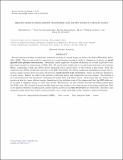Files in this item
Heating effects from driven transverse and Alfvén waves in coronal loops
Item metadata
| dc.contributor.author | Guo, Mingzhe | |
| dc.contributor.author | Van Doorsselaere, Tom | |
| dc.contributor.author | Karampelas, Kostas | |
| dc.contributor.author | Li, Bo | |
| dc.contributor.author | Antolin, Patrick | |
| dc.contributor.author | De Moortel, Ineke | |
| dc.date.accessioned | 2018-11-19T15:30:15Z | |
| dc.date.available | 2018-11-19T15:30:15Z | |
| dc.date.issued | 2019-01-10 | |
| dc.identifier | 256614421 | |
| dc.identifier | 05dcf698-b008-414a-a903-56120ad37bac | |
| dc.identifier | 85060229452 | |
| dc.identifier | 000455820100001 | |
| dc.identifier.citation | Guo , M , Van Doorsselaere , T , Karampelas , K , Li , B , Antolin , P & De Moortel , I 2019 , ' Heating effects from driven transverse and Alfvén waves in coronal loops ' , Astrophysical Journal , vol. 870 , no. 2 , 55 . https://doi.org/10.3847/1538-4357/aaf1d0 | en |
| dc.identifier.issn | 0004-637X | |
| dc.identifier.other | ORCID: /0000-0002-1452-9330/work/52888674 | |
| dc.identifier.uri | https://hdl.handle.net/10023/16502 | |
| dc.description | Funding: This project has received funding from the European Research Council (ERC) under the European Union’s Horizon 2020 research and innovation programme (grant agreement No.724326 and No.647214) (IDM). P.A. acknowledges funding from his STFC Ernest Rutherford Fellowship (No. ST/R004285/1). | en |
| dc.description.abstract | Recent numerical studies revealed that transverse motions of coronal loops can induce the Kelvin-Helmholtz Instability (KHI). This process could be important in coronal heating because it leads to dissipation of energy at small spatial-scale plasma interactions. Meanwhile, small amplitude decayless oscillations in coronal loops have been discovered recently in observations of SDO/AIA. We model such oscillations in coronal loops and study wave heating effects, considering a kink and Alfvén driver separately and a mixed driver at the bottom of flux tubes. Both the transverse and Alfvén oscillations can lead to the KHI. Meanwhile, the Alfvén oscillations established in loops will experience phase mixing. Both processes will generate small spatial-scale structures, which can help the dissipation of wave energy. Indeed, we observe the increase of internal energy and temperature in loop regions. The heating is more pronounced for the simulation containing the mixed kink and Alfvén driver. This means that the mixed wavemodes can lead to a more efficient energy dissipation in the turbulent state of the plasma and that the KHI eddies act as an agent to dissipate energy in other wave modes. Furthermore, we also obtained forward modelling results using the FoMo code. We obtained forward models which are very similar to the observations of decayless oscillations. Due to the limited resolution of instruments, neither Alfvén modes nor the fine structures are observable. Therefore, this numerical study shows that Alfvén modes probably can co-exist with kink modes, leading to enhanced heating. | |
| dc.format.extent | 10 | |
| dc.format.extent | 52460794 | |
| dc.language.iso | eng | |
| dc.relation.ispartof | Astrophysical Journal | en |
| dc.subject | Magnetohydrodynamics (MHD) | en |
| dc.subject | Sun: corona | en |
| dc.subject | Sun: magnetic fields | en |
| dc.subject | Waves | en |
| dc.subject | QB Astronomy | en |
| dc.subject | QC Physics | en |
| dc.subject | T-NDAS | en |
| dc.subject.lcc | QB | en |
| dc.subject.lcc | QC | en |
| dc.title | Heating effects from driven transverse and Alfvén waves in coronal loops | en |
| dc.type | Journal article | en |
| dc.contributor.sponsor | European Research Council | en |
| dc.contributor.sponsor | Science & Technology Facilities Council | en |
| dc.contributor.sponsor | Science & Technology Facilities Council | en |
| dc.contributor.institution | University of St Andrews. Applied Mathematics | en |
| dc.identifier.doi | 10.3847/1538-4357/aaf1d0 | |
| dc.description.status | Peer reviewed | en |
| dc.identifier.grantnumber | 647214 | en |
| dc.identifier.grantnumber | ST/N000609/1 | en |
| dc.identifier.grantnumber | ST/R004285/1 | en |
This item appears in the following Collection(s)
Items in the St Andrews Research Repository are protected by copyright, with all rights reserved, unless otherwise indicated.

